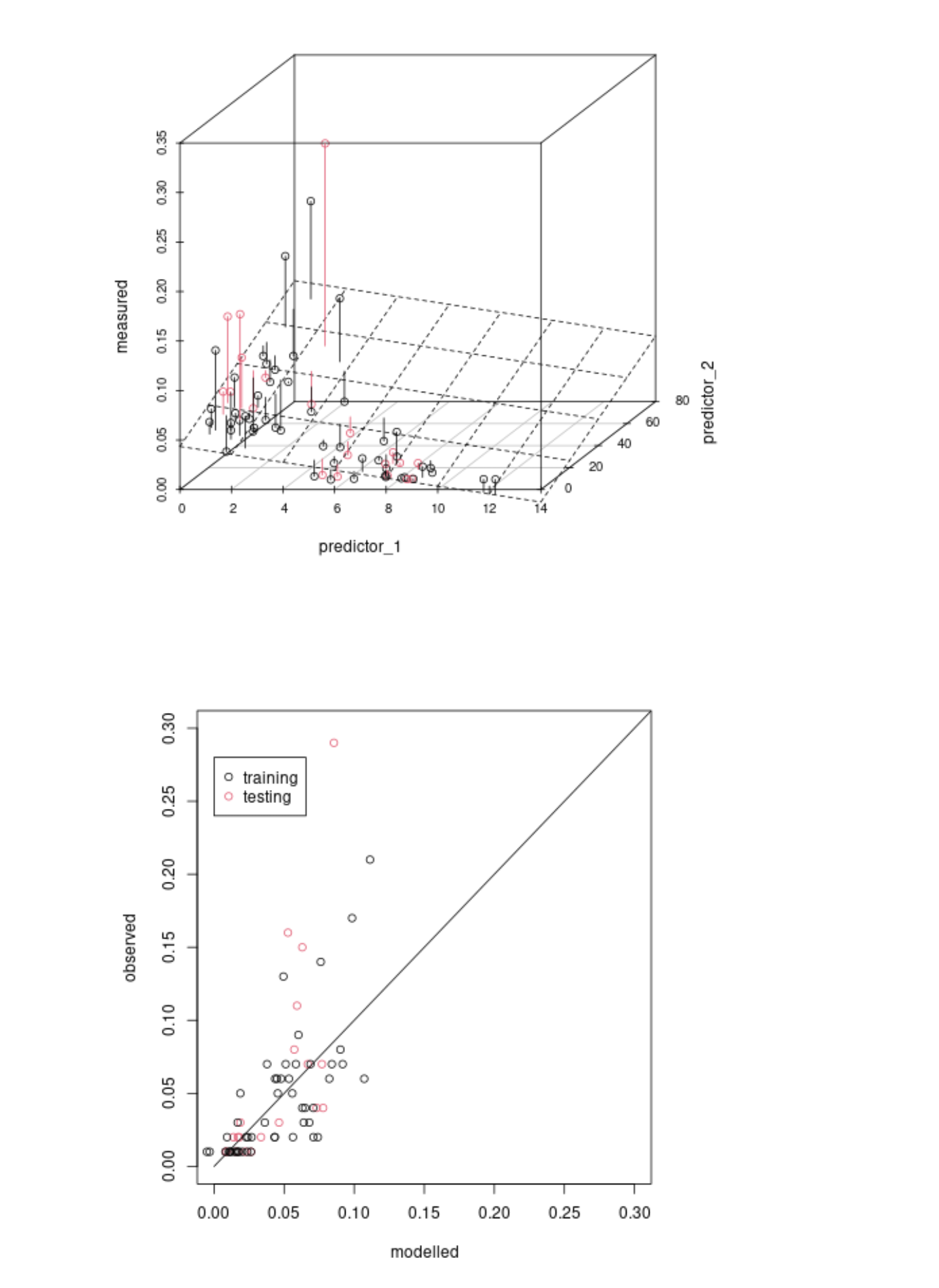As a non-statistician, I am interested in understanding whether model evaluation should be conducted with the measured values on the x-axis and modelled (or predicted) values on the y-axis, or vice versa.
For context, I am teaching a university course on environmental modelling. One of the practicals utilises measured data on river water quality (e.g. measured NO2 concentrations). Based on the characteristics of the river catchment (i.e. land use, geology, soil types, topography) and using testing-training datasets, students are asked to create models to predict river water quality (i.e. modelled NO2 concentrations). EDIT: the measured data are first split into training (70%) and testing (30%) subsets. The models are tuned using the training subsets, and then evaluation is with the testing subsets.
They students are then asked to evaluate the models in a variety of ways, one of which is simply plotting measured vs. modelled data, and comparing the results of linear regression to 1:1. I have included some sample data and code below to illustrate, the results of which are shown here:
EDIT The aim here is to enable students to gain experience of model evaluation, specially thinking about missing variables as well as different types of error (i.e. systematic-random, under- or over-prediction).
This course has run for a number of years but I only recently began to contribute to it, and in checking over the method, I came across the papers by Piñeiro et al. (2008) and Pauwels et al. (2019). The former is highly cited (>700 times) and recommends the following: Observed (in the y-axis) vs. predicted (in the x-axis) (OP) regressions should be used ...
Pauwels et al. (2019) argue that this approach is incorrect and is an artefact of the experiment setup and that instead, assessing models in a scatter plot with the observations in abscissa (X-axis) and the corresponding simulations in ordinate (Y-axis) will lead to the correct conclusions regarding the model performance. This paper has only been cited once since publication.
While I have some understanding of statistics, I am not an expert statistician and would like to know if there is a general rule for evaluating measured-modelled data on the X-Y axes.
## Example Code
import numpy as np
import matplotlib.pyplot as plt
# Input data
Measured = [0.110, 0.150, 0.070, 0.070, 0.040, 0.020, 0.010, 0.020, 0.010, 0.290, 0.040, 0.020, 0.020, 0.010, 0.010, 0.010, 0.160, 0.030, 0.030, 0.080]
Modelled = [0.06, 0.064, 0.078, 0.068, 0.079, 0.019, 0.009, 0.014, 0.016, 0.087, 0.074, 0.034, 0.018, 0.009, 0.023, 0.027, 0.053, 0.047, 0.019, 0.058]
# Set up plot
fig, (ax1, ax2) = plt.subplots(1, 2)
# Plot Measured (X) vs. Modelled (Y), with 1:1 line
ax1.plot(Measured,Modelled, 'ro')
ax1.set_xlabel("Measured values")
ax1.set_ylabel("Modelled values")
ax1.axline([0, 0], slope=1)
# Plot Modelled (X) vs. Measured (Y), with 1:1 line
ax2.plot(Modelled,Measured, 'ro')
ax2.set_xlabel("Modelled values")
ax2.set_ylabel("Measured values")
ax2.axline([0, 0], slope=1)
#obtain m1 (slope) and b1 (intercept) for Measured vs. Modelled
m1, b1 = np.polyfit(Measured, Modelled, 1)
#obtain m2 (slope) and b2 (intercept) for Modelled vs. Measured
m2, b2 = np.polyfit(Modelled, Measured, 1)
#add linear regression line to scatterplot
ax1.plot(Measured, m1*np.array(Measured)+b1, color='orange')
ax2.plot(Modelled, m2*np.array(Modelled)+b2, color='orange')
# using padding
fig.tight_layout(pad=1.0)
plt.show()
## **EDIT**
# Full input data, including predictors, split by test-training
group = ["Testing","Testing","Testing","Testing","Testing","Testing","Testing","Testing","Testing","Testing","Testing","Testing","Testing","Testing","Testing","Testing","Testing","Testing","Testing","Testing","Training","Training","Training","Training","Training","Training","Training","Training","Training","Training","Training","Training","Training","Training","Training","Training","Training","Training","Training","Training","Training","Training","Training","Training","Training","Training","Training","Training","Training","Training","Training","Training","Training","Training","Training","Training","Training","Training","Training","Training","Training","Training","Training","Training","Training","Training","Training","Training","Training","Training"]
measured = [0.11,0.15,0.07,0.07,0.04,0.02,0.01,0.02,0.01,0.29,0.04,0.02,0.02,0.01,0.01,0.01,0.16,0.03,0.03,0.08,0.08,0.02,0.07,0.05,0.06,0.03,0.09,0.07,0.03,0.04,0.07,0.17,0.03,0.01,0.05,0.01,0.01,0.04,0.01,0.01,0.01,0.14,0.21,0.04,0.02,0.02,0.03,0.02,0.01,0.02,0.01,0.01,0.01,0.02,0.01,0.01,0.01,0.02,0.06,0.06,0.02,0.02,0.06,0.06,0.07,0.07,0.07,0.13,0.06,0.05]
predictor_1 = [1.231824555,0.615234151,1.165186392,0.525859101,0.735572055,7.67780908,8.958903593,8.900461024,7.84647476,2.655325443,2.792221068,5.769693553,8.185012004,8.787211459,5.962420116,5.297960321,1.479561438,5.255290898,7.885828985,0.738002703,0.483714239,1.928896113,0.514826816,1.629628135,1.067315635,0.487807436,0.961284723,0.639645339,2.083082213,1.816748332,1.14119713,0.798762487,7.004250655,12.22349063,8.000742572,9.017686869,11.75561384,3.944032552,9.432875808,9.136357158,8.595211952,3.552441934,1.014219737,3.166220771,5.648604781,5.078663497,4.869929446,7.760899685,8.529723683,6.461895963,6.707680902,5.852565035,5.046068182,7.239011985,7.770876954,7.852262871,7.432389029,0.907447671,0.654238481,1.823821963,9.255090086,0.885662936,1.296456938,0.741698994,2.262652753,1.785146869,2.334035797,0.852653873,1.615497552,2.260345848]
predictor_2 =[20.94380929,22.28754677,38.81228455,25.88769612,37.95297372,5.306122449,0.71199097,6.019852706,3.647733194,53.617942,41.58515404,13.3125,6.267806268,0.436681223,2.730375427,4.155021427,15.40168664,24.30683482,6.862044317,16.93954187,49.46439824,35.71915474,51.2345679,19.19191919,43.77224199,26.84396699,20.8882198,10.34992607,29.30439073,27.18836218,45.91439689,59.22795797,1.314405889,0.245813489,7.367230134,0.675378065,0.442993705,43.89086595,6.382160707,10.60371517,2.124943,47.69738512,73.13639511,34.74692202,5.964254636,20.48104956,12.4137931,11.84210526,1.167031364,26.07170694,0.805951643,0,3.050847458,8.497854077,3.602941176,2.43567753,10.25430681,34.79212254,67.48427673,8.855545749,2.836335761,16.58502449,15.38725154,7.392759355,34.95531281,22.39939256,3.680501175,9.542991065,6.595855307,11.16022099]




modeleddata predicted values from a model trained on themeasureddata, or are they predictions from a model trained previously on a different dataset? 2) If the latter, are you trying to see if the model needs to be updated, or something like that? 3) Does the model represent something like a simplified or baseline understanding of the phenomenon, & you want to see the information that is being missed? Something else? Some additional context would help. $\endgroup$